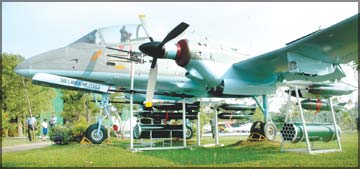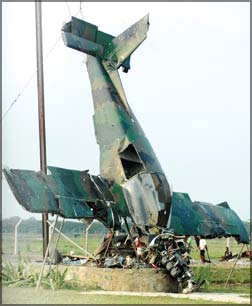|

Sri Lanka Air Force Museum at Ratmalana:
Air power of the past
Jayanthi LIYANAGE
The trek of nine-acre land of the Sri Lanka Air Force Museum at the
Ratmalana Air Force Base is an experience you are not likely to forget.
It is a ramble of discovery for both the young and the old who have
missed out on the country’s aviation history during the generations that
have flown.
|

SLAF gun ship with heavy armaments of guns, pods, missiles
and rockets. Pix: Saman Sri Wedage |
The hangars displaying vintage aircraft, helicopters, vehicles and
civil engineering machinery speak of the legacy handed down to the Royal
Ceylon Air Force (RCyAF) in 1951, during the tenure of Governor-General
Lord Soulbury, when RCyAF’s forerunner British Royal Air Force (RAF)
relinquished command. Anaesthetic and sterilising units and other health
service equipment left at Katunayaka RAF hospital survives to date. The
photo gallery of over 1,000 photographs gives a flash back to the
pre-independence era, the days of RCyAF which finally paved the way for
the establishment of Sri Lanka Air Force (SLAF) when Ceylon changed to
the Democratic Socialist Republic of Sri Lanka in 1972, and its
aftermath of war and peace. You also read about Squadron Leader L.J.
Brichall, a Canadian, who was nicknamed as “the Saviour of Ceylon” for
alerting the RAF when he saw Japanese armada of Pearl Harbour attack
approaching Ceylon, while reconnoitring in his Catalina which crashed
under the armada’s onslaught. “If not for him, we might have been a
Japanese colony, instead of a British colony,” commented Sqn. Ldr.
Harsha Fernando who guided The Daily News across the museum premises to
ensure that the essentials would not be missed.
A hint of the combative strength of SLAF, contained in the display of
aircraft weaponry, and the surrounding flower-drenched garden with
outdoor displays of modern aircraft, gunships and other attractions are
part of the educational tour. SIG 50, 90 and 125 are indigenous mortars
made at SLAF’s Explosives Ordnance Unit at Sigiriya when a huge demand
for them was generated in the eighties. In this only Air Museum of Sri
Lanka, all aspects of the air force are highlighted. “We want to have as
many visual aids as possible to educate the young and the laymen as they
do not have a source to get this information,” Sqn. Ldr. Fernando
explained.
|

Squadron Leader Malinda Perera |
The oldest light aircraft in the museum are of prime historic value
and had been manufactured in British plants which have now changed over
to other industries. Tiger Moth, a bi-plane made under license from De
Havilland Aircraft Company in England, by Morris Motors Ltd., Oxford,
and handed over to RAF in Ceylon in 1940, is the oldest aircraft in Sri
Lanka. It passed hands to Colombo Flying Club and then to SLAF which
restored it to fly-worthy condition. Tiger Moth had enjoyed a flying
stint of half-an-hour just three weeks ago. Chipmunk is RCyAF’s
first-flown aircraft, built by De Havilland and brought to Ceylon in
1951, as a basic trainer for flight cadets.
The museum has two of the only three complete Balliols surviving in
the world today. RCyAF had been the only foreign operator to buy
Balliols, manufactured by Boulton Paul Aircraft Ltd., United Kingdom.
That was in 1954. The third is preserved at the British Museum. Pioneer,
built by Scottish Aviation Ltd. in Prestwick, was acquired by RCyAF in
1956. A low-speed aircraft not requiring a lengthy runway for take-off,
it had served as an ambulance and a recovery aircraft.
English-made Dragon Fly was RCyAF’s first helicopter, bought in 1955.
The other historically-valued helicopter is Russian-built Kmov which
uses the principle of main rotors instead of the usual tail rotor.
British-made Dove, bought in 1955, was a cargo-carrying aircraft. Air
Ceylon started with Dakotas. MiG 15 and 17, Russian Jets, were bought in
1971, for defence against insurgencies. Italian-made Siai Marchetti and
Argentinian-built Pucara are more modern aircraft with armaments and
have been successfully used for bombing in the eighties and nineties,
respectively.
|

The plane that attacked the Katunayake Airport |
An MI-24 helicopter gunship used in the recently concluded war is
displayed with its armaments. The museum has maintained two Siais, two
Chipmunks and one Tiger Moth in fly-worthy condition.
“In museums of other countries, old aircraft are painted and kept but
it is hard to maintain them in fly-worthy condition,” Air Force Museum
Unit Commanding Officer Sqn. Ldr. Malinda Perera explained. Pazmany is
the first aircraft assembled by SLAF. Centurion X Ultra Light was
fully-built locally by a team of engineers, headed by Wing Commanders
Varuna Senarathne and Nihal Jayasinghe. Wing Commander Senarathne is
expected to fly this aircraft at the museum opening.
Among vintage machinery is the Blackstone Engine, the first power
source for RAF in 1945. Built in Stamford, England, and originally used
in frigates, British later converted it as a generator. The Blackstone
will be the stand-by power source for the museum. Link Trainer, designed
by Edward Link in 1919, simulates a cock pit and trained RAF pilots in
1940s. A mechanical crab attached to it, enables the instructor to
create different scenarios of speed, turbulence and time and monitor the
trainer’s responses. They are no longer available in Sri Lanka, but the
museum’s Link Trainer is restored to operational standards. Thames truck
is RCyAF’s first 3-tonne vehicle used in 1951 and can still be driven to
transport people. When the Pope visited Sri Lanka in 1968, he was driven
around in a Land Rover Defender Jeep, a ceremonial vehicle used by
Governor-General William Gopallawa for Independence Day parades.
Scammell tractor, built around 1947 and used in the sixties as a towing
tractor and a recovery vehicle, is still serviceable.
|

RCyAF’s first flown aircraft Chipmunk |
The piston-driven water pump is a residue left in China Bay by Royal
Navy Air Arm which was the first to establish itself in Trincomalee
before RAF arrived. Powered by an English-made Lister engine, it pumped
sea water for washing and other purposes. Listers are supposed to be
durable for generations. An electric pump displays its handles and
tubing, made of brass and copper before the advent of stainless steel.
An old Telephone Exchange, in which the operator pulls caller plugs and
inserts in receiver sockets, still stands. A parachute ejection seat of
a jet aircraft which, in an emergency, ejects the pilot with both seat
and parachute, is another novelty.
Uniforms from RAF khaki shorts era to the present day royal blue of
both air men and women are on display. Although Women’s Wing was formed
in 1988, four recruited in 1971 as air hostesses to a commercial
airliner of RCyAF, were the first local women to be inducted to an armed
service. A stall depicts the evolution of aircraft engines from piston
to turbine engines. Flags of all SLAF bases and detachments are flown.
The museum, being an independent formation, will have its own flag.
A mini video theatre simulating a commercial airline, a lecture room
conducting aviation lectures for students on request, a war victory
area, a children’s park, a European-styled maze grown with Ganga Werella,
a cafeteria built from old sleepers and a souvenir shop with crockery,
ties, t-shirts, cuff links, pens and miniature aircraft, all carrying
SLAF insignia, enhance the experience.
Explore the solid mechanics of this past and comprehension of the
progression of the country’s air defences over the years, dawns on you.
The bustle of last minute renovation work is scattered across the
soon-to-be opened Sri Lanka Air Force Museum. “The unique idea of
establishing a separate Air Force Museum came from the present Commander
of Sri Lanka Air Force, Air Chief Marshal (ACM) Roshan Goonetileke who
identified the need to have a museum in this environment of peace,” Air
Force Museum Unit Commanding Officer, Squadron Leader Malinda Perera,
told the Daily News. “He personally monitors and guides every activity
of the museum.” His perseverance and enthusiasm for renovation to reach
a quick completion contributed to the opening being a reality. A past
Commander ACM Harry Goonetileke, the father of the present Commander,
had collected the larger part of the old aircraft lying at the
Katunayake Sri Lanka Air Force (SLAF) Base when he established a museum
in an old hangar on September 24, 1979. During the command of ACM Walter
Fernando, ACM Fernando shifted the museum to Ratmalana and ran it as
part of an Air Craft Preservation and Storage Unit in which aircraft
component overhauls and general engineering activity was done.
Aeronautical Engineering Director, Air Commodore Jayanath Kumarasiri
serves as the Chairman of the Air Force Museum Project.
“From the establishment of Royal Ceylon Air Force (RCyAF) in 1951 to
date, we have flown a number of aircraft and used a variety of
machines,” said Sqn. Ldr. Perera. “We cannot forget the past. We need to
preserve and depict that history to inform the general public and the
generations to come. They must know what machines we have used and what
we have fought the war with. If these aircraft are phased-off and we
allow them to lie where they are, they will deteriorate as all of them
are made of fabric and aluminium. To preserve them, continuous
maintenance has to be done, collecting them in a place like this, and
that is what we are doing.” The museum houses 47 phased-off aircraft,
covering 30 types that were used from 1951. Sqn. Ldr. Perera requested
schools to inform the museum prior to their visits so that guides can be
arranged to accompany them on the rounds. |



